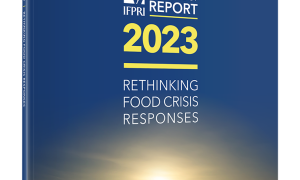Food systems and diets underpin many critical challenges to public health and environmental sustainability, including malnutrition, noncommunicable diseases, and climate change, but sustainable healthy diets have the unique potential to reshape th
Search
We assessed the potential effectiveness of human milk banking and lactation support on provision of human milk to neonates admitted in the newborn unit (NBU) at Pumwani Maternity Hospital, Kenya.
Children's consumption of ultra-processed foods (UPF) is increasing in Ethiopia, but relatively little is known about the specific feeding practices that underlie this pattern.
Availability of national polices, programmes, and survey-based coverage data to track nutrition interventions in South Asia
Progress to improve nutrition among women, infants and children in South Asia has fallen behind the pace needed to meet established global targets.
Modelling policies to improve affordability and consumptionof nutritious foods for complementary feeding in Kenya
In Kenya 26% of children under age 5 experience stunted growth, 4% are wasted and 11% are underweight. In pregnant women, the prevalence of iron deficiency is 36% and iron-deficiency anaemia prevalence is 26%.
Nutrition-sensitive agriculture programmes have the potential to improve child nutrition outcomes, but livestock intensification may pose risks related to water, sanitation and hygiene (WASH) conditions.
لقد واجه العالم الكثير من الازمات خلال عام 2022.
En 2022, el mundo se enfrentó a múltiples crisis.
En 2022, le monde a subi des crises multiples.
2022年,世界面临多重危机。旷日持久的2019冠状病毒病疫情(COVID-19)、重大自然灾害、内乱和政治动荡以及气候变化日益严重的影响对食物系统的破坏仍在继续,而与此同时,俄乌战争和通货膨胀加剧了全球粮食和化肥危机。危机数量不断增加,多种危机的叠加影响日益加剧,饥饿人口和流离失所者数量不断攀升,促使人们呼吁重新思考粮食危机应对措施,从而为变革创造了一个真正的机会。
In 2022, the world faced multiple crises.
Agrifood value chains in the world’s low- and middle-income countries (LMICs) have expanded rapidly over the past decade, supplying an increasing volume and diversity of food products.
Recent global crises have led to diverse impacts across the world’s low- and middle-income regions, reflecting local conditions and differing policy responses.
Over the past two decades, social protection programs have become a mainstream policy tool to address chronic poverty and food insecurity in low- and middle-income countries (LMICs).
Global and national agrifood systems are vulnerable to a variety of shocks that have caused major disruptions to food production, markets, and livelihoods over the past two decades, and have set back efforts to reduce poverty, food insecurity, and
In human, economic, and environmental terms, the total cost of disaster and crisis response is extremely high, and the disastrous combination of the food price crises coming on the heels of the COVID-19 pandemic and natural calamities is straining
In 2022, the world faced multiple crises.
Now is the time to rethink how we address food crises. Better prediction, preparation, and resilience building can make future crises less common and less devastating, and improved responses can contribute to greater food security, better nutrition, and sustainable livelihoods
Gender inequality exists everywhere, but it is particularly stark in fragile and conflict-affected settings (FCAS).
Migration is a recurrent, complex, and multidimensional phenomenon driven by a broad set of factors.

